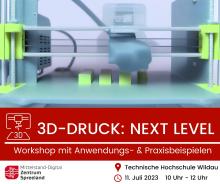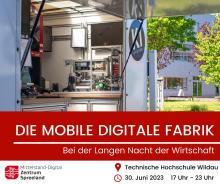Prof. Dr. Alexander Stolpmann
Prof. Dr. Alexander Stolpmann holds the professorship for image processing in industrial production at the Wildau University of Technology (TH Wildau). His field of research is intelligent image processing systems using soft computing methods such as neural networks and genetic algorithms.
3D-Druck Next Level Workshop
Long night of business (Lange Nacht der Wirtschaft LDS)
With the roadshow MOBILE DIGITAL FACTORY, you will get to know diverse application examples in the field of digitalisation and artificial intelligence in the manufacturing industry.
Immerse yourself in the exciting world of innovative technologies and discover the opportunities they offer for your company.
Prior registration is not required - just come along and be part of it!
More about the event: https://t1p.de/e3piw
More about LONG NIGHT OF BUSINESS: https://t1p.de/f0g05
Horizon Europe (HORIZON)
The current framework program for research and innovation, “Horizon Europe”, promotes research into important societal issues. HORIZON officially launched on January 1, 2021. The second of the three program pillars, Global Challenges & Industrial Competitiveness (Pillar II), offers companies the opportunity to get involved in joint projects.
Further information on the program website of TH-Wildau
Zentrales Innovationsprogramm Mittelstand (ZIM)
“Zentrales Innovationsprogramm Mittelstand (ZIM)” is a nationwide, technology and industry-open funding program with which the innovative power and thus the competitiveness of medium-sized companies strengthened in the long term. The program aims to support companies in developing value creation potential and raising the level of application-oriented knowledge.
Program webpage BMBF: https://www.zim.de/ZIM/Navigation/DE/Home/home.html
Further information on the program website of TH-Wildau
Digital Europe Programme (DIGITAL)
The “Digital Europe Programme” places a special focus on digitalization. It aims to bridge the gap between digital technology research and its application, and aims to bring the research results to the market - for the benefit of European citizens and businesses, especially SMEs. Investments under the Digital Europe program will support the EU's twin objectives of "green and digital transitions" to strengthen the EU's resilience and open strategic autonomy.
Further information on the program website of TH-Wildau

